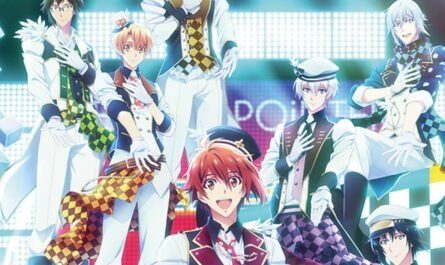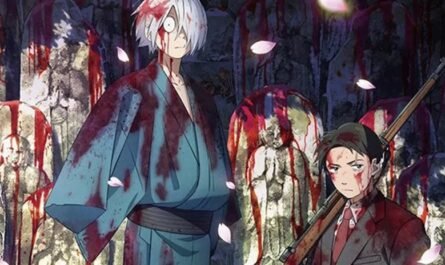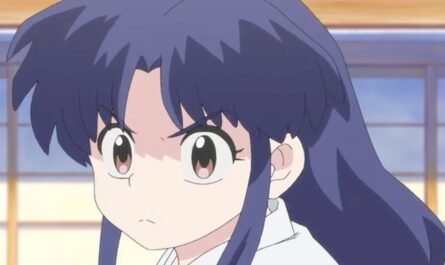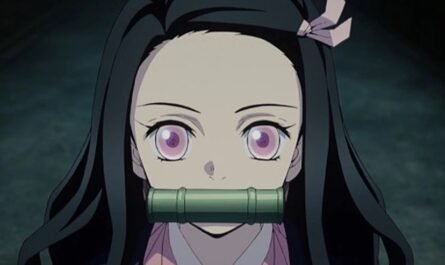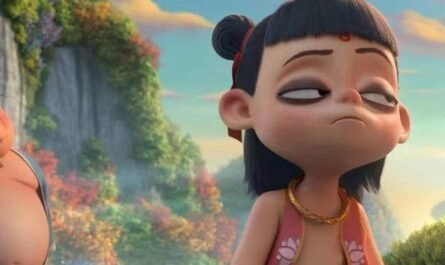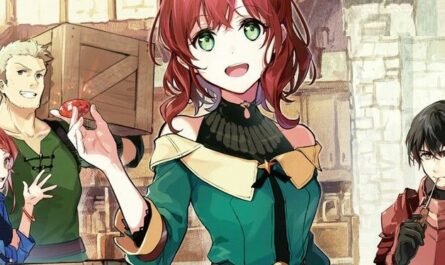“Twins Hinahima” is a work that fully incorporates AI into anime production, utilizing supportive AI. AI is becoming increasingly prevalent in video production, with films utilizing AI being created as a result of this work. However, this anime is a pioneering work that utilizes AI in Japanese television and theatrical anime. We asked the production staff of this work about the current state and effects of AI use, as well as their opinions on the future relationship between anime and AI.
Half a year has passed this year, and summer anime, which has more titles than spring anime, has begun to air one after another. With the final chapter of “Demon Slayer: Kimetsu no Yaiba” being released in theaters, the anime world seems to be more lively than usual. Among them, this time we focused on the anime “Twins Hinahima,” which was broadcast on TV on MBS, TOKYO MX, and other networks in March.
This work fully incorporates AI into anime production in the form of supportive AI. AI is becoming increasingly widespread in video production, with movies utilizing AI being created as a result of this development. However, this anime is a pioneering work that pioneers the use of AI in Japanese TV and theatrical anime. Therefore, we consulted with the production staff of this work regarding the current state and effects of AI use, as well as their opinions on the future relationship between anime and AI.
The work of the people who made “Twins Hinahima.” This time, we spoke with three individuals from “Twins Hinahima”: director and animation producer Naomichi Iizuka, AI/3D technical director Ultra-noob, and cinematographer Masayoshi Ozawa. Let me briefly explain what kind of work he did.
Director/Animation Producer: Naomichi Iizuka. As a director, he checks and directs to improve the quality before the director reviews it. He is also responsible for converting location photos into backgrounds, retouching, and determining layouts. As an animation producer, he was responsible for discussions with partner companies and advertising agencies.
AI/3D Technical Director: Ultra-noob. He is responsible for programming-related tasks, refining staff ideas, and developing AI workflows. In addition to unraveling complex issues and converting and adjusting them for AI, he was responsible for creating 3D simulations and exporting images. He converts rough drawing materials drawn by animators into AI cells, which are then used to generate character movements and drawing styles.
Director of Photography: Masayoshi Ozawa. He adjusts the balance of colors and light when characters and backgrounds created by different staff members are combined, and finishes the work by compositing effects. In addition to adjusting the perspective on the screen, he also performs tasks such as unifying color changes, a common feature in AI. Some fundamental technologies have yet to be realized in AI.
For example, the background cannot be made transparent, so it has a single color. The color of the characters changes depending on the cut, which necessitates cutting out and filling in the colors. According to Iizuka, this placed a significant strain on the film crew. Producing anime using AI was a continuous process of trial and error. Copyright is often an issue when using generative AI. Still, Twins Hinahima is based on the premise of operating within Japan and was produced by the government’s “AI Business Guidelines.” Additional learning is achieved solely through the staff’s creativity, with no external input required.
In addition, copyrights are sorted out by adding human hands to the production footage, and it is possible to use it on an operational basis. These are also reviewed by lawyers, and let us first note that, under current law, everything is clear. Next, we will present an interview with the three of them about the challenges of actual production and the benefits of using AI. First, we asked them about the process of deciding to use AI. How did you choose to use AI for Twins Hinahima? Naomichi Iizuka (hereafter, titles omitted): The starting point was not to use AI in the work, but to use AI to make an anime, and from there, the work “Twins Hinahima” was decided. KaKa Creation had released videos of the main characters on social media, and the decision was made to develop the anime. The atmosphere of society is still not such that AI is used in normal anime production, and it doesn’t seem easy to do so unless the project is based on AI. – What was the background to planning to produce anime using AI? Iizuka: AI has emerged as a technology with new possibilities and potential to support anime production sites, so we decided to try using it first. There was an aspect of using it in the sense of research, to try it out and see how it can be explicitly used in anime production sites. There was also the creative aspect of the staff’s interest and my wanting to find a way to create images that can only be done with new AI technology. – Since this was your first time, didn’t it take a long time to prepare? Iizuka: We prepared for half of the production period.
The script was written in June, and the storyboard was completed in August. However, the production team continued to prepare throughout August and conducted trial-and-error testing until October. Ultra-noob: However, the things created during that time can become assets that lead to the next work, which is also a strength of AI. Iizuka: The good thing about AI, which is different from hand-drawn animation, is that it can be stored like that. Until now, characters from the same angle have been redrawn many times, but AI can learn how to correct this and utilize the knowledge for future use. With hand-drawn animation, it was not possible to streamline or accumulate, but I feel that AI has made it possible to approach such areas.
However, as the number of things we can do has increased, there has also been a disadvantage in that one more process has been added, making it more difficult. –When new technology appears, there is often a rejection reaction, isn’t there? Iizuka: Mr. Ozawa, you said that it was the same as when CG first appeared. Ozawa: I’ve been working on cell-look animation with CG, and in the early days, I was criticized a lot because the shadow expression was not as good as hand-drawn animation. Recently, I’ve finally reached the point where I can make it into shape, but initially, I was often criticized. So, even though the points being raised about the AI this time are slightly different, I feel it’s similar. It took 20 years for the cell to get to this point, so I think it will take some time for the AI to do the same. How did you train the AI? Iizuka: For this project, we had the character designer, Takumi Yokota, train the AI. It is learning from the drawings of Mr. Yokota. It has not been trained on drawings or materials from other companies found on the Internet, nor has it been trained on additional materials whose copyrights have not been cleared. Ultra-noob: Other than Mr. Yokota’s drawings, it has not been trained on anything special. I was impressed that the scenes that made me want to use a supercomputer were drawn in one go. How do you use AI in “Twins Hinahima”? Iizuka: It’s more accurate to say that it was used partially rather than creating the whole, and it is linked to the concept of supportive AI. Of course, people make the characters and scripts that form the foundation of the work, and 80% of the characters are initially created by hand or through CG. Ozawa: It’s just that AI is used to make 3D models look hand-drawn in normal anime production.
The character movements are created with 3D software, but if left as they are, they appear as polygonal characters. Therefore, we use AI to give them a cell-like appearance. If you use 3D software, you will understand that it might be closer to rendering. Iizuka: The backgrounds are also created by people as a base, and we used AI to process them, such as anime backgrounds, and to streamline the cleanup part. In terms of efficiency, did you save time by using AI? Iizuka: It helped with things that were done by hand, like coloring and cleaning up lines. Ozawa: As a director, I think it’s easier to ask for retakes. Many things are changed or cut after delivery, but if you use AI, you can close it up to the last minute and improve the quality. Ultra-noob: There were quite a few backgrounds to redo in this work, but I feel that it was pretty helpful because it was done within a day. Iizuka: We made 30 to 40 backgrounds per cut, so we made more than 1,000. You can’t do that with normal anime.
Also, it’s difficult to ask for retakes on things that an animator has spent a lot of time creating, and it takes time, but with AI, it’s easier for the checker to say, “Can’t we do it a little more like this?” It’s easier to request retakes because a person does not draw them; instead, they are rendered by adjusting parameters and other settings. What do you think about the quality of AI animation? Iizuka: We think we’ve made it to a level that can be used as a TV anime.
However, AI struggles with structures, so for example, if you place a chair in the background, the entire scene will become unstable or collapse somewhere, requiring human intervention. Ultimately, we infused a human touch into all elements and supplemented the challenging parts with AI. Was there any part that would have been difficult without AI? Iizuka: At the end of the film, there is a waterfall that falls into the inside of a huge round hole, but it would not be easy to do it by hand, and CG would be expensive. Any method up to now would have been complicated, but with AI, we were able to output it in one go. Ozawa: It would probably take about two months to create that waterfall with CG. First, you create the ocean, and then you have time to get it checked by the director. Then, it takes another few days to make it so that it falls into the hole.
This time, we successfully created a beautiful waterfall. Iizuka: I have experience in charge of the ocean as a CG producer, and it isn’t easy. It takes an incredibly long time to calculate the simulation of the ocean surface, and the amount of calculations is so significant that you would want to borrow a supercomputer. I was impressed that it came out in one go. Are there any other scenes created with AI that you think are amazing? Ultra-noob: I want you to see the scene where the hair is blowing. We were able to convert the secret ingredients that only we could handle, and we were able to create a scene that would have been difficult to achieve by hand, as well as the shoes and cups.
In the past, they would have been painted in solid color, but now they have fine details, which is something that only AI can do. Iizuka: The hair is fantastic throughout the entire work. Usually, it would be such a difficult task that a dedicated person would be required, but the approach of having the AI write out the work based on a CG model proved effective. CG is logical, and AI is an intuitive technique. On the other hand, have you ever had any difficulties with AI? Ultra-noob: A typical example would be hands. When AI draws them, they tend to break down, and there are so many fingers that they have to be fixed by a human, so it was a challenge until the very end. Iizuka: We couldn’t do the in-between. When creating anime, it is often said that AI is expected to replicate the movement between the original drawings.
However, this time we did not adopt it because it had not reached a level that could be aired as a TV anime. Although it does come out, it is often broken or far inferior to what a human would draw. Mechanical movements are fine, but AI lacks a concept of time continuity, so it behaves strangely. –Is this what you’d expect as technology advances in the future? Iizuka: Yes. CG is a logical technology, but AI is an intuitive technology, and it can’t draw a straight line from here to here. I mentioned earlier that AI is not good at structures, but AI doesn’t draw by calculation; it simply draws from what it has learned. Therefore, when it generates a straight line, it doesn’t have a logical reason.
The background, etc., falls apart if you change the camera angle a little. Iizuka: That’s right. CG never falls apart, but AI is an intuitive technology, so it draws without understanding that this is here. It draws in a way that suggests there is something here from the data it has learned. It doesn’t understand the structure of the human body, so, for example, when drawing a finger, it draws a nail because it thinks there is something there, but it ends up in a completely unexpected position. It draws in a way that says it will look like this based on what it has learned so far. There is something strange about the picture from the bridge that appears at the end of the film. Iizuka: That was done intentionally, as part of the direction. I retouched the image well up until the bridge, but from there to the climax, I made it so that you unconsciously feel that something is strange. It was a direction that leveraged the characteristics of AI.
What about the flow of the river just before the bridge scene? Iizuka: That is the limit of AI in a sense (laughs). Ozawa: It isn’t easy to express water. Ultra-noob: But even though it is the same water, I was surprised that the water coming out of the tap turned out to be a surprisingly beautiful video. When I tried it, I managed to capture a good video, and it was straightforward. Iizuka: Before I started animation production, I didn’t know what I could do, so I experimented with various things and found out some things. I kept the tap water that worked well at that time and asked the director to incorporate what I could use. Ultra-noob: There are some things you can’t know about AI until you try it. When I wanted to create a cut like this, even if you’re told to do it, you won’t know until you try it, so it’s frustrating to be unable to say for sure that you can do it. Sometimes, a good thing emerges when you try it multiple times, so we managed to guarantee it.
However, the disadvantage is that you won’t know until you try it. How should creators deal with AI? The use of AI is expected to increase in the future, but as a creator, how do you think it should be dealt with? Ozawa: Hand-drawn animation will remain hand-drawn in anime. Conversely, I believe that CG cell-like animation will eventually give way to AI, which will take its place. If you render it at the end with a cel-look, it can take hours to create one frame. And if you have to do hundreds of those, building 10 workstations would cost several tens of millions of yen in total. Even so, corrections require time, such as redrawing. In this respect, AI can be utilized in a short time and with minimal capital investment. Iizuka: For creators, what they used to paint by hand becomes the bucket tool of graphic software, and AI can do even more with it.
AI is a tool, and if you look at it optimistically, many more useful tools will emerge, making it easier to create. Ozawa: The same goes for people working in CG, and many people are starting to use AI. There is a trend in AI now, so if you don’t get on board with it, you will be left behind. CG has also changed tools as tools have evolved, but those who cannot do that have no choice but to move on to a different field. Now that AI is being integrated into existing software, it will become inevitable to utilize it in the future. Iizuka: AI will be increasingly adopted in CG studios. However, there is indeed opposition, especially in the fields of drawing and animation, and there are opinions that it is physically impossible.
This is a natural reaction, so it will take some time for it to be introduced in anime studios. –Will this allow people who have never been able to draw to become creators? Iizuka: Many people who use generative AI are motivated by the fact that they can’t draw themselves, but are happy to see the pictures that come out. However, for people who can’t draw but want to participate in creating works, it could be a tool that bridges that gap. Ultra-noob: It’s not a good idea to leave it all to the AI and release the finished product as is.
This work aims to create high-quality images by processing the original material and feeding it into the AI, then having people redraw the unusual parts of the picture and refeed it into the AI again. In this way, I want people to use AI from the perspective of utilizing it as a tool to enhance quality, for example, by converting the illustrations they have drawn into animation or taking them to the next level. Finally, please share a message with those who are considering watching “Twins Hinahima” after reading this. Iizuka: It’s an anime that you can watch quickly in one episode, and it’s a work that will leave you feeling very satisfied after watching it, so I hope you will watch it casually. We have been working on this animation for almost a year to improve it. I hope you will watch it casually and find a scene that makes you think, “Wow!” Ozawa: During filming, it was challenging to blend the AI-generated drawings with the hand-drawn ones seamlessly, so I hope you will watch that part. Ultra-noob: There are different merits to hand-drawn animation and CG animation.
I would be happy if you could watch it as a work of other vectors, as an AI animation, and as a work in a new field that has never been seen before. Iizuka: For those who have already seen it, it is a work that presents many meta-challenges, so it would be interesting to watch it again from a meta-perspective, considering how each cut and each image was created. Ultra-noob: Many people have published on the Internet how AI images are generated, but many techniques are surprisingly unknown. We discover many such hidden uses in our daily research, and they are hidden throughout this work. I enjoyed working as if I were a researcher. I hope that everyone can enjoy using AI, not just to generate illustrations. Thank you. AI continues to evolve day by day.
Even after “Twins Hinahima” was broadcast, new products have emerged and latest functions have been added, rendering cutting-edge technology quickly outdated. It is clear that we are entering an era where we have no choice but to incorporate these technologies into the creative field. By combining this AI, we can let computers handle tasks that are within their capabilities, and instead spend more time on tasks that require human expertise. In this way, the anime production site, which is often criticized for its harshness, will improve even slightly, and viewers will be able to watch even higher-quality works.
The evolution of technology will have a positive impact on both those who create anime and those who watch it. “Twins Hinahima” is currently being distributed on various distribution sites. If you are interested after reading this, take a moment to watch it. For details about the work, please refer to the “2025 Spring Anime Special”. Text by MOVIEW Shimizu


